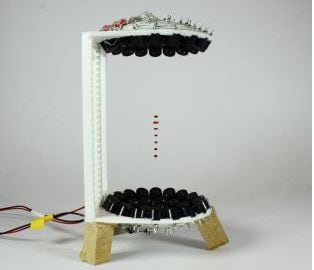The contactless food-delivery system, devised by University of Sussex researchers, levitates tiny amounts of food and drink using low-cost ultrasonic transducers to form waves that carry the food.
The technology can be fine-tuned to such a degree that it can even deliver food in a certain order, such as cheese followed by wine, or together, such as espresso with milk.
According to lead researcher Dr Chi Thanh Vi, a research fellow at the University of Sussex, “chefs across the world have become increasingly fascinated by exploiting novel technologies.
“Indeed, most of us are familiar with molecular gastronomy, where the physical and chemical make-up of food is changed to deliver new taste experiences,” he added.
“Foams, gels and fogs are all common sights on plates in Michelin-starred restaurants these days.”
Future food tech
Dr Vi believes the work could form a framework in which to create novel gustatory experiences and interfaces not just for dining, but also for gaming, movie experiences, and interactive storytelling in VR.
For the food industry, the use of this technology alongside such innovations as foams, gels and fogs can only further add to the tastes, textures and flavours the merging of food and technology is achieving.
Along with colleagues from the University of Bristol, the team began by enrolling 11 participants (7 males, 4 females, mean age 30) to assess the effect of acoustic levitation on taste perception, comparing three basic taste stimuli (i.e., sweet, bitter and umami) and three volume sizes of droplets (5 microlitres (µL), 10µL and 20µL).
Results indicated that users perceived sweet and umami easily, even in minimal quantities, whereas bitter was the least detectable taste, despite its typical association with an unpleasant taste experience.
Making veg more enjoyable

“Our results show that users can perceive and effectively discriminate different taste stimuli,” the study concluded.
“Most interestingly, we observed that the hedonic quality of the bitter taste is modulated in the levitation condition, making it a less unpleasant taste.
“This modulation could be a game-changer in food-interaction design for children, for example making eating vegetables more enjoyable and be thought of as a contactless delivery system, for example for paralysed users.”
While the current proof-of-concept device can only levitate tiny food morsels, the team added that the TastyFloats concept's vision was to deliver bigger items in the future, allowing more complex combinations of food items, almost like a meal.
Source: ISS '17 Proceedings of the 2017 ACM International Conference on Interactive Surfaces and Spaces
Published online ahead of print: doi.org/10.1145/3132272.3134123
“TastyFloats: A Contactless Food Delivery System.”
Authors: Chi Thanh Vi, Asier Marzo, Damien Ablart, Gianluca Memoli, Sriram Subramanian, Bruce Drinkwater, Marianna Obrist
